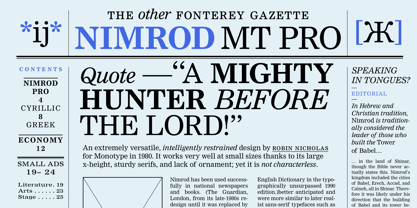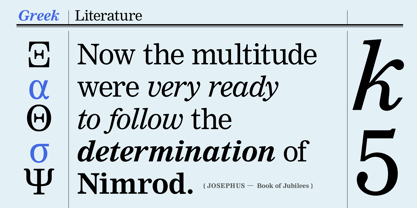Sélectionnez ce type de licence lorsque vous développez une application pour iOS, Android ou Windows Phone et que vous intégrez le fichier de fonte dans le code de votre application mobile.
Nimrod®
par Monotype

- AaGlyphs
-
Meilleure offreOffres familiales
- Styles individuels
- Spécifications techniques
- Licences
Par style :
$77.33
Paquet de 3 styles :
$231.99
A propos de la famille Nimrod Police
Un design extrêmement polyvalent et intelligemment sobre, créé par Robin Nicholas pour Monotype en 1980. Il fonctionne très bien dans les petites tailles grâce à sa grande hauteur de x, ses empattements robustes et son manque d'ornementation, mais il n'est pas dépourvu de caractère.
Nimrod a été utilisé avec succès dans des journaux et des livres nationaux. (The Guardian, Londres, depuis sa refonte à la fin des années 1980 jusqu'à son remplacement par une interprétation de Miller par Carter en 1998 ; le Concise Oxford English Dictionary dans l'édition de 1990, inégalée sur le plan typographique).
Concepteurs : Robin Nicholas
Éditeur : Monotype
Fonderie : Monotype
Fonderie d'origine : Monotype Typography
Maître d'ouvrage : Monotype
MyFonts débout : 12 décembre 2001

À propos Monotype
La bibliothèque de Monotype est l'une des collections de caractères les plus vastes et les plus complètes au monde. Elle comprend des dessins originaux d'importance historique et une nouvelle gamme de caractères contemporains et à la mode : polices. La bibliothèque de Monotype comprend des milliers de classiques intemporels, des reprises artisanales et des dessins originaux provenant des créateurs de caractères et des fonderies les plus innovants de l'histoire. Cette bibliothèque distinctive et primée de polices offre aux marques et aux concepteurs une sélection large et fiable de caractères pour une typographie expressive à l'impression et à l'écran. La page Premium Foundry peut être consultée ici.
En savoir plus
Lire moins